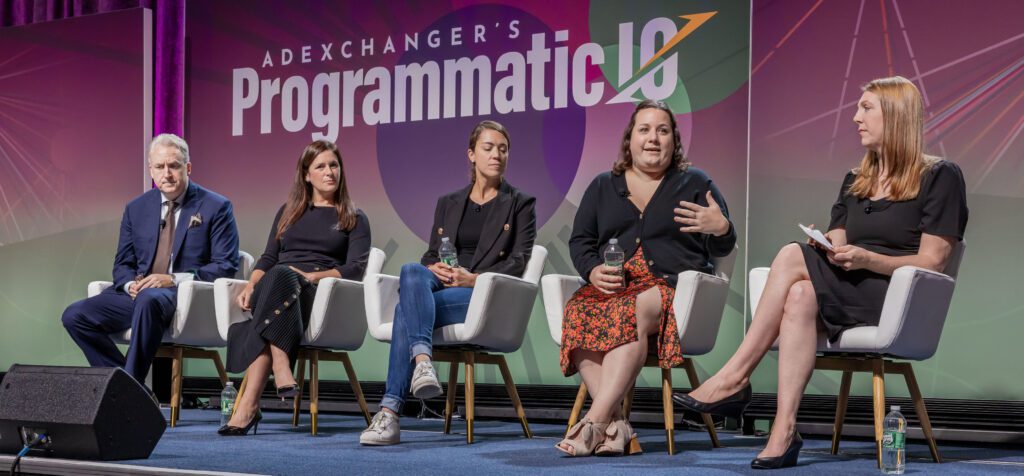
Programmatic advertising aims to simplify the ad-buying process for everyone involved. However, as more players enter the space, complications have arisen, and traffic isn’t optimized. Going forward, communication between all parts of the supply chain is critical to ensure everyone has what they need to succeed.
Supply path optimization is a topic that has the industry buzzing right now because a lot of changes are happening, and not all of them are easy to understand. Whether you’re on the sell or buy side of the equation, tracking these changes and understanding how they may impact your business going forward is important.
A panel at AdExchanger’s Programmatic I/O in New York City on September 26 titled “The SPO Squeeze” dove into this subject headfirst. The chat was moderated by Sarah Sluis, Executive Editor, AdExchanger, and featured Jess Breslav, Chief Customer Officer, Index Exchange; Will Doherty, VP Inventory Development, Publishers, The Trade Desk; Katie Evans, Chief Operating Officer, Magnite; and Lara Koenig, Global Head of Product, MiQ.
Increasing Value and Efficiency in SPO
Koenig is on the buy side of the SPO journey, and she shared that SPO is a crucial problem for buyers to tackle right now. The current setup creates a slew of problems for marketers.
For example, there are too many intermediaries in the supply chain. “About three years ago, we got supply chain logs from our DSPs. We thought we were buying from six different supply vendors, but when we looked at the logs, we figured out that in reality 384 downstream vendors are participating in our auctions, which leads to so many safety, suitability and economic risks,” Koenig explained.
Marketers can succumb to many pitfalls, and almost as many folks are trying to solve the problems with SPO. The problem is that with the multitude of emerging platforms the goal of programmatic – to simplify the process for buyers – is being lost.
One potential solution to this problem is bidding through open paths. This eliminates some of the hops back and forth and saves time. Doherty says this also ensures you see the true number of avails, giving the buyer a more accurate depiction of a supplier’s inventory, which allows them to compare and contrast publishers.
“What open path has allowed us to do and where the market is going is it’s starting to consolidate around the top. As that consolidation occurs, the economic benefits for both the publisher and the buyer become much clearer,” Doherty notes.
As an industry, we need to start redefining the word “value” in terms of partnerships. Breslav says, “Gone are the days where you add a partner and expect immediate outcomes, immediate ad spend.” The value may be in benchmarking performance and relaying that information to partners.
Open path is future-facing, says Evans, toward new technologies like CTV, which operates very differently. “We’re trying to create an ecosystem that is going to be successful for the future, based on all the technologies that have developed over the last five or six years,” she says.
Seeing Double: Duplicate Impressions Limit Value
Duplication in impressions is a concern when each publisher is partnering with 35-40 SSPs. SSPs are all sending the same things to DSPs, and the DSPs are not getting the rest of the picture, creating problems for buyers.
From a buyer’s perspective, says Koenig, partner companies are largely doing the same thing – collapsing intermediaries to make buying more direct. The pressing question now is whether supply chain intermediaries add any value.
Doherty notes there are two types of duplication – publishers working with multiple partners and within SSPs themselves, tuning up or tuning down traffic, which leads to intra-SSP duplication. Some DSPs will lean into solely getting their match traffic, possibly even only for what they historically bid on. This can reduce your bottom line and limit your reach.
Decisions based on a DSP’s customer portfolio and what buyers have bought in the past can limit pathways for new buyers and over complicate the process, forcing buyers to work with multiple DSPs to get the reach they’re looking for. Koenig believes there should be transparency in the process that empowers buyers to advocate for the pathways they want to pursue. The current process also hurts the SSP because they are sending avails that aren’t monetized.
To combat this, Breslav recommends better communication between SSPs and DSPs. “Filtering done correctly helps our partners to be more successful and buyers on the other side of it. Part of that is about a conversation making sure that we are all aligned on what we are sending each other and using traffic shaping as a tool when it’s effective,” she shares.
A View Toward the Future
Communication within the industry is crucial for making sure pain points continue to be addressed and that we remain on the same page. In the face of a shifting digital landscape with emerging technologies, ultimately we all want the same thing – to succeed.
The complicated landscape makes it more difficult than ever for SSPs to drive positive outcomes for publishers. According to Breslav, there is a flight to quality and safety as well as a focus on sustainability, and all of these considerations are changing how the industry views strategy and innovation.
She adds, “I think there’s an incredibly healthy dialogue happening in our ecosystem right now, and I really appreciate it. I think about what I read in the trades and the push towards sustainability. Our community feels incredibly active. I think that that’s a wonderful thing.”
Looking ahead, experts agreed that it is important to avoid letting new technologies like CTV fall into the same trap we’re currently in with duplication and intermediary traffic. In the coming years, there will likely be some consolidation of players, particularly intermediaries, in addition to greater efficiency and quality. The consensus was cautious optimism about what the future holds.